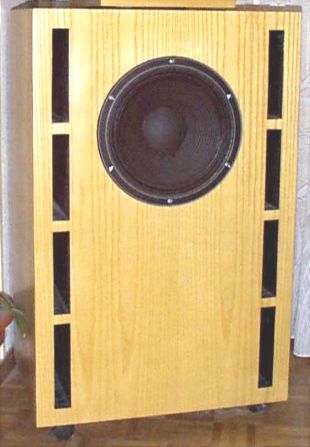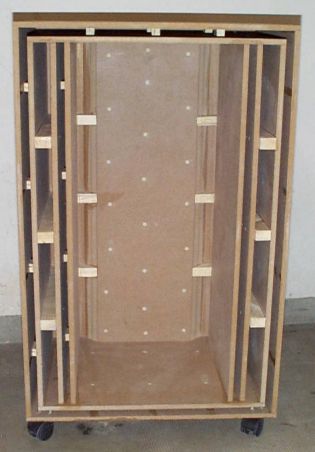
The wood part of the work is achieved.
The MDF walls are 12mm (~0.5") thick.

The lead sheets (1mm, 0.04" thick) are applied with wood glue and stapples.
Back to home page
Back to audio main page
Back to loudspeakers main page
In closed boxes, the back wave of the speaker should be completely absorbed (=
converted in heat) by the damping material.
As the speaker is nearly transparent to sonic waves, if a back wave returns after a
reflection on the back wall, some part will also come out through the speaker with some
delay giving a not very clean sound.
The walls should not transmit to the outside any vibration. Only the speaker should
radiate.
So a perfect damping material would not only damp the walls but also absorbs direct radiation.
In bass-reflex, most of these arguments are also valid.
The only difference is the vent should transmit its box/vent frequency range so damping is
not complete for the extreme lower frequency.
Here is a description of a treatment I apply to my loudspeakers.
This technique uses double-walls and the space between them is filled with fine sand.
It's a great way to damp the walls themselves. Sand is also very cheap: you can have it
for free on most beaches ...
Mine is coming from the "Bibione Pineta" beach (for those who know it, close
to the "Tre Casoni" restaurant), between Venice and Trieste in Italy. That was
our holydays resort when I was a child, lots of good souvenirs ...
I remember the sand was extremely fine and, well, it is.
This sand has a density of 1.7 and a granulometry of 0.25mm (0.01").
It should be completely dry and sifted before using it.
You can store it in small carton boxes which let it dry by diffusing humidity through the
walls (plastic doesn't).
I sometimes mix the sand with lead granulates (see below) to increase damping.
Sand can be used in every enclosure type but also in horns. I've seen medium horns using this technique and very thin double walls ...
It's a good thing to keep a hole on top of the enclosure that could let you add some
sand after several weeks of usage.
Add sand, press with wood stick and tap on the enclosure with a large rubber hammer.
Repeat this process until it becomes hard to add sand.
Lead is one of the rare materials that is effective in sound damping also for very low
frequencies.
Lead sheets are glued onto the internal walls.
In Switzerland we can find them in stores specialized in metals and metallic hardware
(mainly for professionals).
These lead sheets are used for noise damping in house construction (between walls, floors,
...) and are conditioned in rolls.
For example, mine were 42cm (16.5") wide, 6m (20 feet) long and 1mm (0.04")
thick and weighs around 30kg (65 pounds) but you can have other dimensions.
The price for lead in sheets is not very high: around 3CHF per kg (end 97), 0.90$ per
pound.
As lead is soft, you can easily cut the sheets with big scissors.
If you have a press, it could be good to "laminate" them on the walls before
assembling the box.
As I don't have one, I build the box, cut the sheets to the right dimensions, glue and
stapple them onto the internal walls.
I flatten the surface with a large rubber hammer and let them dry.
With MDF, I've used 4mm (0.16") stapples. With softer wood you can use bigger ones.
I've used wood glue which is longer (1day) to dry, you can also use contact cement but you
must position the sheet right at the first contact ...
As the entire surface is glued, you need an appreciable quantity of glue ...
I use also lead in granulates (nearly sand, <1mm granulometry) mixed with sand for
the double walls but this one is *much* more expensive: around 4 times more than lead
sheets !
For budget conscious projects, this one should be omitted.
Asphalt is normally used for car chassis treatment and is conditioned in cans or in sprays.
The layer of asphalt is applied with a brush, so you can easily vary its thickness.
Once dried, the thickness diminishes quite a lot.
With asphalt in spray, you can obtain a more regular surface: I've used it in the vents of
my bass-reflex boxes.
While drying, asphalt stinks a lot !!
You should let it dry for one week before closing the enclosure.
In some difficult to reach places, you should wait more or ventilate them artificially.
Apply it in a well ventilated room: after a while, I was nearly drunk when applying it in
a non-ventilated room ...
Of course, you should still continue to use classic damping materials like glass wool, ...
My medium is a 17 liters closed box with an Audax PR17HR37TSM in the 600-4KHz range.
The box was already built, I just wanted to improve it.
Lead and asphalt treatment was applied.
Before the treatment, knocking the box gave a clear sound, now it's much more mate,
deaf.
The medium becomes clearer and crisper with less agressivity, much finer.
Double-walls with leaded sand, lead sheets and a double asphalt coating is used for these bass-reflex boxes.
 The wood part of the work is achieved. The MDF walls are 12mm (~0.5") thick. |
 The lead sheets (1mm, 0.04" thick) are applied with wood glue and stapples. |
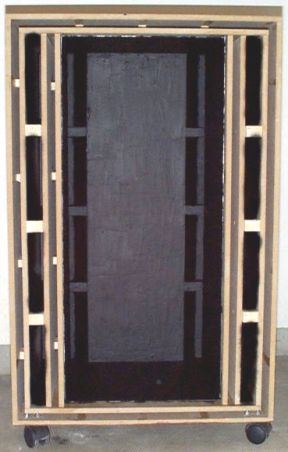 Two layers of asphalt are applied over the lead. The vents are covered with asphalt in spray. |
 The sand (just a part is shown) and lead. As lead is much more dense than sand, the 12kg (25 pounds) seem a small quantity compared to sand. Sand must be perfectly dry. A good tip is to let it dry in cartons: humidity will pass
through the walls. |
 A large squared plastic box is used to mix them. The meter gives a good indication of the volume. A funny thing: as lead is heavier than sand, it does not remain on the surface but just 1-2mm under ... The 43 liters of sand fill the double walls. |
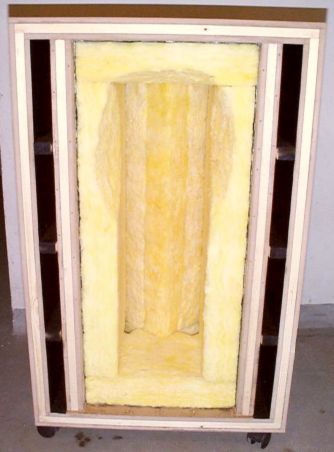 Because of the weight, they become difficult to manipulate ... |
 A detail of the position of the glass wool. |
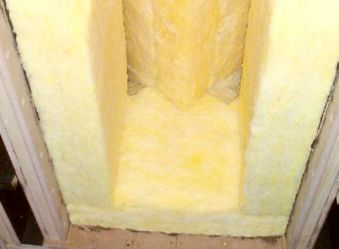 and an image ... |
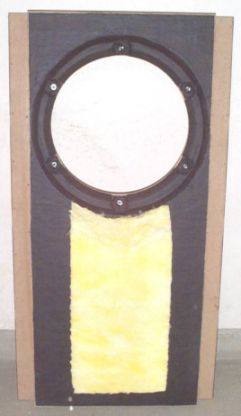 The front wall seen from the inside. |
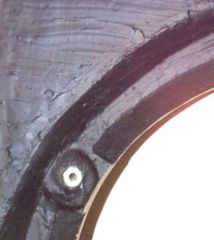 A detail of the fixation of the driver. A nut is glued (thermo glue) and the driver is screwed with a bolt which allows high tightening torques. A champfer allows a better rear sound flow. Sand, lead and asphalt are also used. |
And the finished product:
